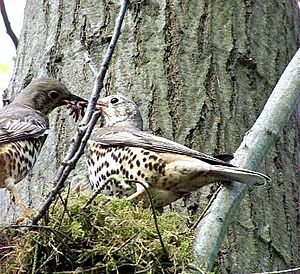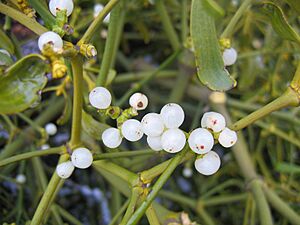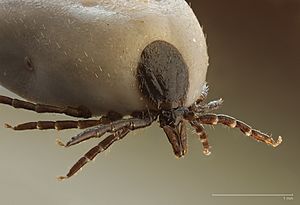Mistle thrush facts for kids
Quick facts for kids Mistle thrush |
|
|---|---|
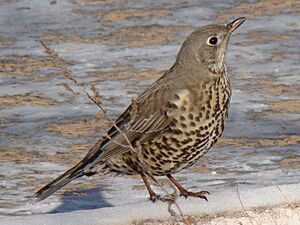 |
|
| In Baikonur, Kazakhstan |
|
| Conservation status | |
| Scientific classification | |
| Genus: |
Turdus
|
| Species: |
viscivorus
|
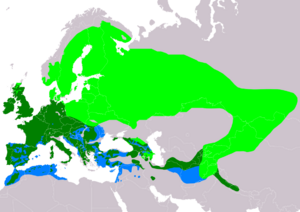 |
|
| Range of T. viscivorus
Breeding Resident Non-breeding |
|
The mistle thrush (Turdus viscivorus), sometimes called the missel thrush, is a large bird found across much of Europe, temperate Asia, and North Africa. Many mistle thrushes stay in the same area all year. However, those from colder northern and eastern regions fly south for winter. They often travel in small groups.
This thrush has light grey-brown feathers on its back. Its chin and throat are greyish-white. Its chest is yellowish-buff and its belly is off-white, both covered in black spots. Male and female mistle thrushes look very similar. The male has a loud, clear song that can be heard far away. He even sings in bad weather, which is why this bird is sometimes called the stormcock.
Mistle thrushes live in open woods, parks, hedges, and farms. They eat many different things, including invertebrates (like worms and insects), seeds, and berries. They especially love the berries from mistletoe, holly, and yew plants. The mistle thrush's name comes from its love for mistletoe. This plant is a parasitic species, meaning it grows on other plants. The thrush helps mistletoe spread its seeds. When the bird eats the berries, it later poops out the seeds onto tree branches, where they can grow. In winter, a mistle thrush will fiercely protect mistletoe clumps or a holly tree. This helps them save food for when it's hard to find.
Mistle thrushes build their nests in trees. They are very brave and will defend their nests from animals and even people. A typical nest has three to five eggs. The female bird usually sits on the eggs for 12–15 days to keep them warm. The baby birds leave the nest about 14–16 days after hatching. Most mistle thrushes have two sets of babies each year. This bird's population grew a lot in the 1700s and early 1800s. Recently, their numbers have gone down a little, possibly because of changes in farming. But because there are still so many of them and they live in such a large area, experts say the mistle thrush is not in danger.
Contents
About the Mistle Thrush
What's in a Name?
The mistle thrush was first described by a famous scientist named Carl Linnaeus in 1758. He gave it the scientific name Turdus viscivorus. The word Turdus is Latin for "thrush." Viscivorus means "mistletoe eater." This name comes from viscum (mistletoe) and vorare (to devour). So, its scientific name literally means "thrush that devours mistletoe." Its English name, "mistle thrush," also comes from its love for mistletoe berries. "Mistle" is an old word for the plant.
There are over 60 types of thrushes in the Turdus group. These birds usually have round heads, long, pointed wings, and sing beautiful songs. Scientists have studied their mitochondrial DNA to learn about their family tree. The mistle thrush's closest relatives are the song thrush and the Chinese thrush.
What Does a Mistle Thrush Look Like?

The mistle thrush is the biggest thrush found in Europe. It is about 27–28 cm (11 in) long. Its wingspan is about 45 cm (18 in). It weighs around 93 to 167 g (3.3 to 5.9 oz). When it's on the ground, it stands tall and straight.
Its back is light grey-brown. Its chin and throat are greyish-white. The chest is yellowish-buff, and the belly is off-white. Both are covered with round black spots. The spots are thicker on the lower chest, making it look like a spotted band. Its long tail has white tips on the outer feathers. The feathers under its wings are white. Its eyes are dark brown, and its beak is blackish with a yellowish bottom part. Its legs and feet are yellowish-brown.
Male and female mistle thrushes look the same. Young mistle thrushes look similar to adults. However, their upper parts are paler, and they have smaller spots on their yellowish undersides. By their first winter, they look almost like adults.
What Does a Mistle Thrush Sound Like?
The male mistle thrush has a very loud and musical song. It sounds like clear whistles, often repeated three to six times. He sings to mark his territory, attract a mate, and stay connected with his partner. His song is similar to the song thrush or blackbird, but it's less varied and slower. However, it's much louder! You can often hear it up to 2 km (1.2 mi) away.
The male sings from a high spot, like a treetop. He sings mostly from November to early June. He is loudest in the early morning. He often sings during or after wet and windy weather. This is why he earned the old name "stormcock." You might hear his song in any month, but it's rare in July and August when he is changing his feathers.
The main call, used by both male and female, is a dry, chattering sound like "krrrr." It gets louder when the bird is scared or excited. Some people say it sounds like a football rattle. They also make a squeaky "tuk" sound to keep in touch.
Where Mistle Thrushes Live and What They Do
Where Do Mistle Thrushes Live?
The mistle thrush lives and breeds across most of Europe and temperate Asia. It is not found in the far north where there are no trees. In warmer southern areas, it prefers milder uplands and coastal regions. The southern type of mistle thrush lives in North Africa, Corsica, and Sardinia.
Some mistle thrushes are migrants. Birds from the north and east fly to warmer parts of Europe and North Africa for winter. Birds from Scandinavia and Russia start moving south from mid-September. Many spend winter in Europe, western Turkey, and the Middle East. Large numbers cross the Strait of Gibraltar in October and November. However, very few cross the North Sea. Mistle thrushes in the British Isles and northwest Europe usually stay in their home areas or move only short distances. In the Himalayas, breeding birds move to lower areas for winter.
Mistle thrushes live in many different places with trees. These include forests, tree farms, hedges, and town parks. In the south and east, they live in coniferous (pine) woodlands. They can even live above the main tree line where small juniper plants grow. They breed at high altitudes in mountains, sometimes up to 1,700 m (5,600 ft). In winter or during migration, they also use open areas like farms, moors, and grassy hills.
This bird has changed where it lives over time. In Germany, it used to live only in pine forests until the 1920s. Then, it quickly moved into farmland, and later into towns and city parks. In areas with a lot of farming, like eastern England, they have moved from farms to built-up areas with more green spaces. In 2017/2018, a mistle thrush was seen in Miramichi, New Brunswick, Canada. This was the first time this bird was ever seen in North America! Many bird watchers came to see it.
How Do Mistle Thrushes Behave?
Mistle thrushes are usually seen alone or in pairs for most of the year. However, families stay together in late summer to find food. Sometimes, groups join together to form large flocks when there's plenty of food. It's common to see up to 50 thrushes feeding together at that time. At night, they sleep in trees or bushes, usually alone or in pairs. But in late summer or autumn, families might sleep together.
The mistle thrush spends a lot of time on the ground. It hops with its head held high and its body straight. When it's excited, it will flick its wings and tail. When it flies, it moves up and down in waves, with short glides in between.
Life Cycle and Reproduction
Mistle thrushes start breeding when they are one year old. They usually have one partner for life and stay together all year if they don't migrate. Their territories are much larger than those of other thrushes. The nest area is small, but they use a much larger area (about 15–17 ha or 37–42 acres) for finding food. They often use the same territory year after year.
The male mistle thrush will attack other birds, and sometimes even cats or humans, if they come into his breeding area. Sometimes, the male will bring food to the female during courtship.
Breeding usually starts in mid-March in southern and western Europe. In Britain, it can start in late February. In Finland, it doesn't start until early May. The nest is usually built in a tree, either in a fork of a branch or against the trunk. They might also use hedges, ledges on buildings, or cliff faces. The nest can be up to 20 m (66 ft) high, but 2–9 m (7–30 ft) is more common. Other birds, like the common chaffinch, often nest close to a mistle thrush. This is helpful because the chaffinch is watchful, and the thrush is aggressive, protecting both nests.
The thrush's nest is a large cup made of sticks, dry grass, roots, and moss. It's lined inside with mud and soft grass and leaves. The female builds the nest, but the male might help. Nests built early in the season can sometimes be destroyed by bad weather.
A nest usually has three to five eggs, but sometimes two to six. The eggs are usually whitish-buff or greenish-blue with red, purple, or brown spots. Each egg is about 30 mm (1.2 in) long and 22 mm (0.9 in) wide. The female bird mostly sits on the eggs for 12–15 days to keep them warm. The baby birds are born helpless and covered in soft down. Both parents feed them. They leave the nest about 14–16 days after hatching.
Mistle thrushes usually have two sets of babies each year. In Siberia, they only have one. The male feeds the first group of young birds while the female sits on the second set of eggs. Sometimes, they use the same nest for both groups of babies. The young birds depend on their parents for 15–20 days after leaving the nest.
In one study, about 57% of young mistle thrushes survived their first year. About 62% of adult birds survived each year. Mistle thrushes usually live for about three years. However, the oldest recorded mistle thrush lived for 21 years and 3 months!
What Do Mistle Thrushes Eat?
Mistle thrushes mainly eat invertebrates, fruits, and berries. Their animal prey includes earthworms, insects, other arthropods, slugs, and snails. They sometimes smash snails on a stone, just like song thrushes do. Mistle thrushes have even been known to kill small lizards called slowworms and the young of other birds like song thrushes, blackbirds, and dunnocks.
For plant food, they eat fruits and seeds from bushes and trees. Their favorites are holly, yew, ivy, and mistletoe. They also eat berries from blackberry, cherry, elder, hawthorn, olive, and rose plants. They might eat flowers and shoots of grasses. They will also eat fallen apples and plums. They look for food in their breeding areas and in open fields. Sometimes, they share these feeding areas with redwings or fieldfares.
Young birds mostly eat invertebrates. These are often found on low plants or under bushes, not in open grassy areas like the adults prefer. Adult birds might fly up to 1 km (0.6 mi) from their nest to find food in pastures or plowed fields. After leaving the nest, young birds may stay with their parents until winter.
In winter, individual mistle thrushes or pairs will protect one or more fruit-bearing trees. They prefer trees with mistletoe, the parasitic plant that gives the bird its name. If mistletoe isn't there, holly is the most common tree they choose. Even though thrushes usually feed on the ground, defending these trees helps them save fruit for later in the season when other food is scarce. They defend the trees from other thrushes and birds like bullfinches and great spotted woodpeckers. In mild winters with lots of fruit, they might not defend trees as much and can be seen feeding in flocks. But in harsh winters, a single thrush might be overwhelmed by large flocks of fieldfares, redwings, or Bohemian waxwings.
The mistle thrush is very important for spreading mistletoe. Mistletoe is a plant that grows on other trees. It needs its sticky seeds to land on the branches of suitable trees to grow. The thrush loves the nutritious mistletoe fruits. When it eats them, it digests the fruit but leaves the sticky seeds. It then poops them out, possibly in a good spot for them to sprout.
Dangers and Health
Many birds of prey hunt the mistle thrush. These include different types of owls (like the boreal owl and tawny owl), eagles (like the golden eagle), and falcons (like the peregrine falcon and sparrowhawk). Cats and other birds like crows might target their eggs and chicks. However, parent mistle thrushes are very brave and will defend their nests fiercely, sometimes even attacking humans! The mistle thrush is usually not affected by the common cuckoo, a bird that lays its eggs in other birds' nests.
Mistle thrushes can have tiny creatures living on them, called external parasites. These include different kinds of fleas and ticks, like the castor bean tick. Inside their bodies, they can have internal parasites like tapeworms and nematodes. They can also get blood parasites.
Conservation Status
The mistle thrush lives in a very large area across Europe and western Asia. Experts believe there are between 9 and 22.2 million mistle thrushes breeding in Europe. When you add the birds in Asia, the total number is between 12.2 and 44.4 million. This species used to live in a smaller area. For example, it rarely bred in northern England in the 1700s. But it quickly spread into lowland and coastal areas of Europe during the 18th and early 19th centuries. It started breeding in places where it was rare or not found before, like Ireland (first bred in 1807), Scotland, and the Netherlands. Its range also grew in Denmark, Norway, Hungary, and Austria.
Even though the number of mistle thrushes seems to be going down a little now, the decrease is not fast or big enough to cause worry for conservation. Because there are so many of them and they live in such a huge area, the International Union for Conservation of Nature (IUCN) says the mistle thrush is of least concern. This means it's not currently in danger of disappearing.
The small decline might be because of changes in farming. Many pastures rich in invertebrates and mixed farms have been turned into crop fields or more intensely managed grasslands. In these areas, adult survival, the number of eggs laid, and the success of young birds leaving the nest are all lower. In Finland, losing old forests is thought to have caused a local decline.
Mistle Thrushes in Culture
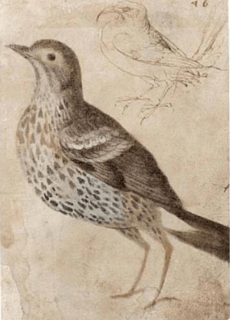
In the early 1500s, a saying by Desiderius Erasmus was "The thrush himself excretes his own trouble." This refers to how the sticky mistletoe berries, which the thrush loves, were used to make birdlime. Birdlime is a sticky substance used to trap birds. So, the thrush was seen as spreading the seeds of its own downfall.
A painting called Mistle Thrush and Alpine Chough by Giovanni da Udine was a sketch for a larger work. This larger work then became the basis for a Raphael fresco (a type of wall painting) in the Apostolic Palace.
An old poem from the Renaissance called "The Harmony of Birds" describes a "thrusshe" (mistle thrush) singing "sanctus, sanctus." This helped tell it apart from the song thrush. The mistle thrush's song is also mentioned in poems like "Darkling Thrush" by Thomas Hardy and "The Thrush" by Edward Thomas.
Because this bird is common and has a loud call, it has many old or local names. These include "screech," "shrite," and "gawthrush." Other names, like "stormcock," refer to its habit of singing in windy and rainy weather. Names like "holm thrush" and "hollin cock" come from old names for the holly tree. This is because the thrush might defend holly trees in winter for their berries.
In Frances Hodgson Burnett's book The Secret Garden, a character named Dickon promises to keep Mary Lennox's secret about the garden. He compares her to a mistle thrush protecting its nest. He says, "If tha' was a missel thrush an' showed me where thy nest was, does tha' think I'd tell any one? Not me. Tha' art as safe as a missel thrush."
The 1971 album Stormcock by singer Roy Harper is named after the mistle thrush. The band Jethro Tull also mentions the bird in their 1977 song "Jack-in-the-Green." The band The Decemberists include the mistle thrush in their 2009 song "Won't Want for Love (Margaret in the Taiga)."
Images for kids



